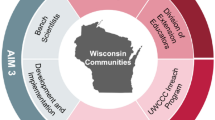Abstract
A Breast Health Research Champion training program was a developed targeting self-identified community breast health advocates from a predominant African-American community with a significant breast cancer mortality disparity. Twelve individuals completed the program that provided training in breast cancer risk and screening, breast cancer research, biospecimen in cancer research, and human research subject protection. The training emphasized four key messages to be disseminated to the community. Trainees hosted a minimum of two social chats with individuals from their social networks and functioned as community researchers, acquiring consent and gathering follow-up data from attendees. Trainees reached 199 individuals from their social networks, and chats were diverse in the venue selected, mode of message transmission, and the audience reached. Post/pre questionnaire data from attendees at the chats showed significant improvement in knowledge, attitudes, and intended behaviors as it relates to breast cancer screening, clinical research, and biospecimen in research. Forty percent of attendees provided 4-week follow-up information. Of respondents eligible for mammography, 38 % had taken action to be screened, and 86 % of respondents had spoken about the information to someone else in their social network. Trainees expressed feelings of empowerment after completing the project, “feeling like the expert,” and all trainees were surprised at the enthusiastic response from attendees of their chats. Trainees continued to disseminate the information learned from the training program during the 6 months following the training, reaching an additional 786 individuals in the community.
Similar content being viewed by others
References
Brawley OW (2004) The study of accrual to clinical trials: can we learn from studying who enters our studies? J Clin Oncol 22(11):2039–2040
Ford JG, Howerton M (2004) The science of recruiting minority populations to screening trials. Clin Trials 1(4):341–2
Lai GY, Gary TL, Tilburt J, Bolen S, Baffi C, Wilson RF et al (2006) Effectiveness of strategies to recruit underrepresented populations into cancer clinical trials. Clin Trials 3(2):133–41
American Cancer Society (2014) Cancer facts & figures 2014. American Cancer Society, Atlanta
Pinsky PF, Ford M, Gamito E, Higgins D, Jenkins V, Lamerato L et al (2008) Enrollment of racial and ethnic minorities in the prostate, lung, colorectal and ovarian cancer screening trial. J Natl Med Assoc 100(3):291–8
Joseph G, Dohan D (2009) Diversity of participants in clinical trials in an academic medical center: the role of the “Good Study Patient?”. Cancer 115(3):608–15
Langford A, Resnicow K, An L (2010) Clinical trial awareness among racial/ethnic minorities in HINTS 2007: sociodemographic, attitudinal, and knowledge correlates. J Health Commun 15(3):92–101
Williams MM, Scharff DP, Mathews KJ, Hoffsuemmer JS, Jackson P, Morris JC, Edwards DF (2010) Barriers and facilitators of African American participation in Alzheimer disease biomarker research. Alzheimer Dis Assoc Disord 24(Suppl):S24–S29
George S, Duran N, Norris K (2014) A systematic review of barriers and facilitators to minority research participation among African Americans, Latinos, Asian Americans, and Pacific Islanders. Am J Public Health 104(2):16–31
Scharff DP, Mathews KJ, Jackson P, Hoffsuemmer J, Martin E, Edwards D (2010) More than Tuskegee: understanding mistrust about research participation. J Health Care Poor U 21(3):879–897
Gibson LM (2000) A four-phase program to recruit African American women into breast cancer promotion programs. ABNF J 11(4):94–96
Cuaresma C, Mitschke D, Robinett H (2007) Capacity building for cancer awareness in Hawai‘i’s foreign-born Filipino communities. Pac Health Dialog 14(1):128–34
Robertson EM, Franklin AW, Flores AM, Wherry S, Buford J (2006) African American community breast health education: a pilot project. ABNF J 17(1):48–51
Mitschke DB, Cassel K, Higuchi P (2007) Empowering natural clinical trial advocates: nurses and outreach workers. Pac Health Dialog 14(1):135–41
Ford M, Wahlquist A, Blake R, Green C, Streets J, Fuller E, Johnson E et al (2012) Assessing an intervention to improve clinical trial perceptions among predominately African-American communities in South Carolina. Prog Community Health Partnersh 6(3):249–263
Virginia Department of Health, http://www.vdh.virginia.gov/ofhs/prevention/cpc/documents/2013/pdf/VA_CCC_2012_Annual_Report%20062912.pdf, accessed on 1/12/2014
Virginia Department of Health. http://www.vdh.virginia.gov/healthstats/stats.htm, Cancer deaths 2003 – 2007, accessed on 7/19/2011
Mosavel M, Rafie C, Cadet DL, Ayers A (2012) Opportunities to reduce cancer barriers: community town halls and provider focus groups. J Cancer Educ 27(4):641–8
NCI (Producer) (2007). Understanding cancer clinical trials [DVD]. United States: Producer
Lemke AA, Halverson C, Ross LF (2012) Biobank participation and returning research results: perspectives from a deliberative engagement in South side Chicago. Am J Med Genet A 158:1029–1037
Rockwell SK, Kohn H (1989). Post-then-pre evaluation. J Extension; 27 (2)
Ainsworth BE, Wilcox S, Thompson WW (2003) Personal, social, and physical environmental correlates of physical activity in African-American women in South Carolina. Am J Prev Med 25(3 Suppl 1):23–9
Christakis NA, Fowler JH (2008) The collective dynamics of smoking in a large social network. N Engl J Med 358(21):2249–58
Strully KW, Fowler JH, Murabito JM (2012) Aspirin use and cardiovascular events in social networks. Soc Sci Med 74(7):1125–9
Barnes J (1954) Class and committees in a Norwegian island Parish. Hum Relat 7:39–58
Acknowledgments
We would like to acknowledge the National Cancer Institute Center to Reduce Cancer Health Disparities for funding this project through a supplement to the Virginia Commonwealth University Minority-Based Community Clinical Oncology Program (U10CA052784 & U10CA052784-20S2).
Author information
Authors and Affiliations
Corresponding author
Rights and permissions
About this article
Cite this article
Rafie, C., Ayers, A., Cadet, D. et al. Reaching Hard to Reach Populations with Hard to Communicate Messages: Efficacy of a Breast Health Research Champion Training Program. J Canc Educ 30, 599–606 (2015). https://doi.org/10.1007/s13187-014-0720-0
Published:
Issue Date:
DOI: https://doi.org/10.1007/s13187-014-0720-0




